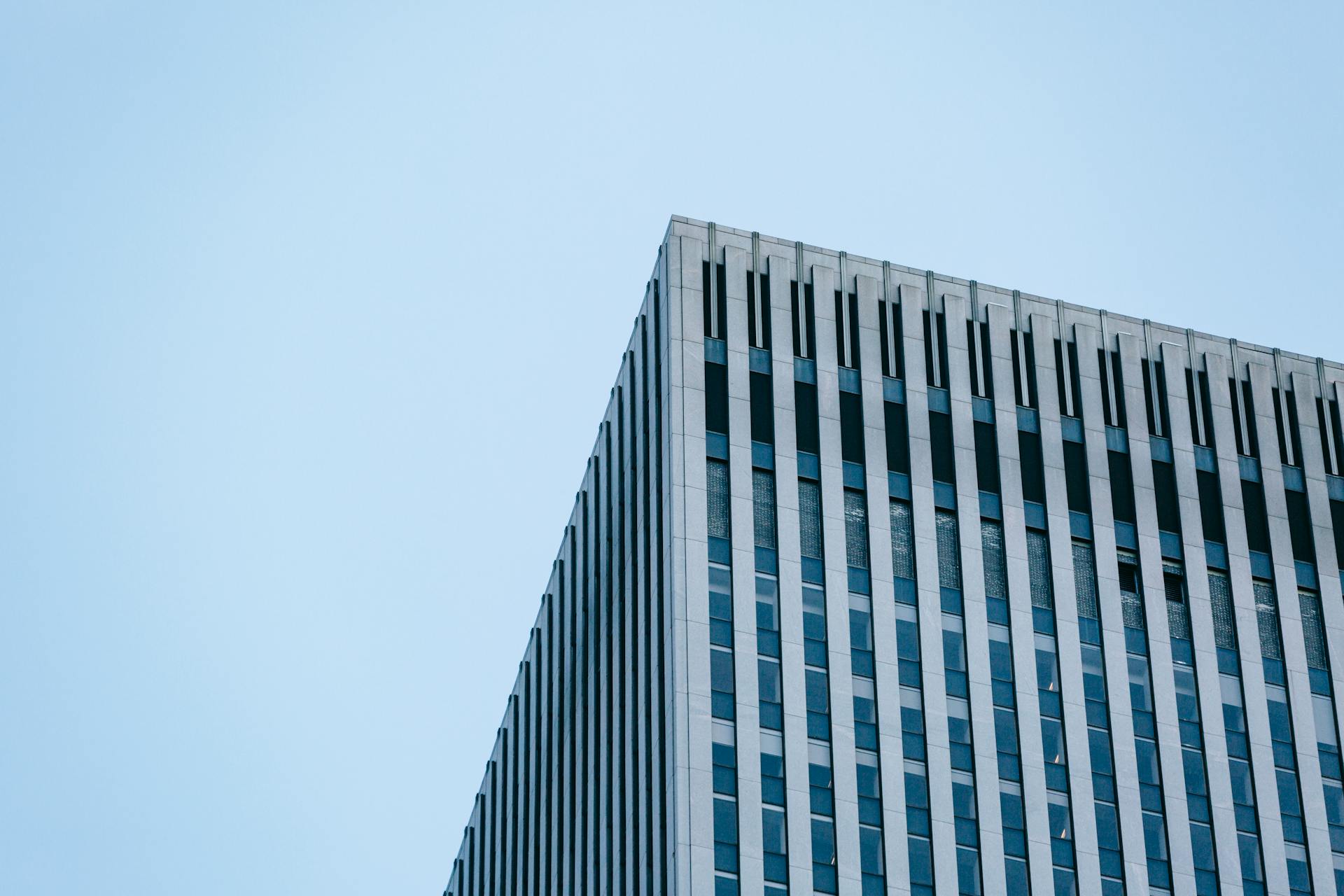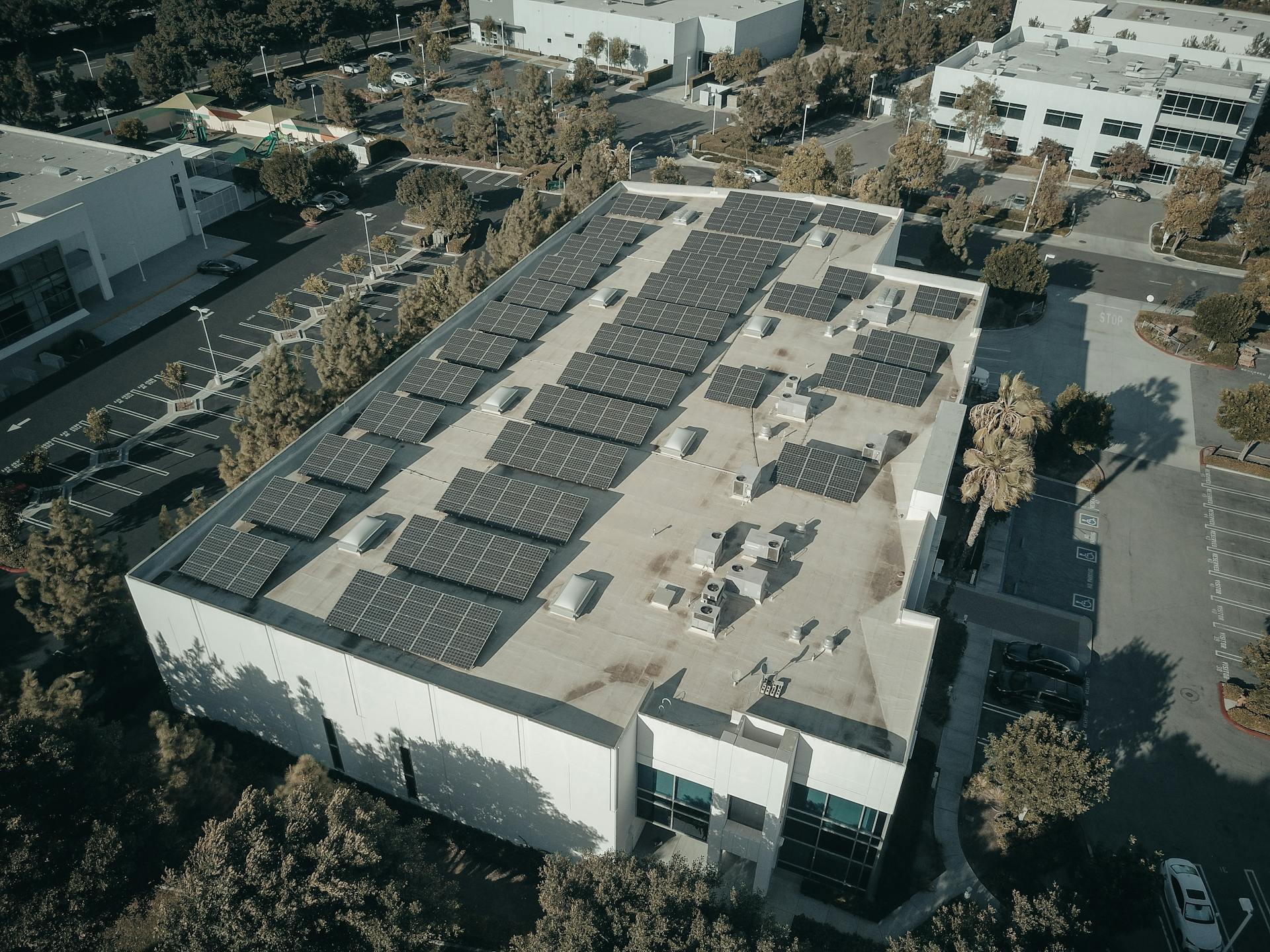
Commercial property insurance is a must-have for any business, protecting your physical assets and financial well-being in case of unexpected events.
As a business owner, you likely have invested a significant amount in your commercial property, including buildings, equipment, and inventory. According to the article, commercial property insurance can help you recover from losses due to damage, theft, or other covered perils.
Having the right insurance coverage can also give you peace of mind, allowing you to focus on running your business without worrying about unexpected expenses.
Commercial property insurance typically covers a range of risks, including damage from fire, windstorms, and vandalism, as well as business interruption and loss of income.
For your interest: Insurance Cover on Business - Merchant Services
What Is Commercial Property Insurance?
Commercial property insurance is a policy that provides financial coverage in case your property is damaged by a natural disaster, a tenant, or another unforeseen issue. It's a type of insurance that business owners or landlords can apply for.
This type of insurance isn't just for property owners; you can also apply for it if you're a tenant or a landlord. The scope of commercial property insurance coverage varies from one company to another, and it also depends on whether you opt for a basic or advanced coverage plan.
Commercial property insurance is a first-party coverage, which means it takes care of what your business owns when damaged in a loss or stolen. It's different from liability protection, which is often included in third-party coverages.
If you own a commercial building, such as a brick-and-mortar business or a strip mall, you'll want to consider commercial property insurance. Your investment property will come with a valuation, which can be either actual cash value (ACV) or replacement cost value (RCV).
Here are the key differences between ACV and RCV:
- Actual Cash Value (ACV): Your insurance company will calculate the payout based on the property's depreciation.
- Replacement Cost Value (RCV): Your insurance company will pay the true cost to replace or repair your property.
Policy Basics
There are many types of property insurance policies available to small business owners.
You can choose from policies that cover a single peril, such as fire or crime, or purchase a package policy that provides protection against many types of loss in one policy.
The majority of small business owners find package policies more convenient and economical.
Insurers often create their own policies or use a standard format from the Insurance Services Office (ISO).
You might enjoy: Vehicle Insurance Policies
What Is Under?
Property insurance policies for small business owners can be complex, but understanding the basics is key. There are policies that cover only a single peril, such as fire insurance or crime policies.
Insurers often create their own policies, but many rely on a package policy format from the Insurance Services Office (ISO). The Businessowners Policy (BOP) is a widely used package policy that provides protection against many types of loss in a single policy.
See what others are reading: Job Injury Insurance
Basic Cause Form
The Basic Cause Form is a crucial aspect of your commercial property insurance policy. It's a form that outlines the specific perils your building is covered against, and it's essential to understand what's included in this form to ensure you're adequately protected.
The Basic Cause Form covers a range of perils, including fire, lightning, explosion, smoke, windstorm, hail, riot, civil commotion, damage caused by an aircraft or vehicle, vandalism, sprinkler leakage, sinkhole collapse, and volcanic action.
If you're not offered the special form, which we highly recommend, the Basic Cause Form is the next best option. However, keep in mind that some insurers may not offer this form due to property condition, vacancy, or loss history.
Here's a list of the perils covered under the Basic Cause Form:
- Fire
- Lightning
- Explosion
- Smoke
- Windstorm
- Hail
- Riot
- Civil commotion
- Damage caused by an aircraft or vehicle
- Vehicles
- Vandalism
- Sprinkler leakage
- Sinkhole collapse
- Volcanic action
It's essential to review your policy or quote to determine which form is included and what perils are covered. This will give you peace of mind and allow you to prepare for potential risks.
Typical Exclusions and Limitations
Flood, earthquake, terrorism, war and military action, intentional damage, nuclear hazard, and normal wear and tear are all typically excluded from commercial property insurance policies.
Some of these exclusions can be covered with a specialized and separate policy, but this is not always the case. In fact, intentional damage and normal wear and tear are never covered by commercial property insurance policies.
If you live in a low-risk area, your insurance company may offer limited coverage for specific perils, but this is rare.
Here are some examples of exclusions you'll typically see on commercial property insurance policies:
- Flood
- Earthquake
- Terrorism
- War and military action
- Intentional damage
- Nuclear hazard
- Normal wear and tear
Causes
The causes of loss form is a crucial part of your commercial property insurance policy, and it's essential to understand what perils are covered and which are not.
The basic cause of loss form insures against 13 specific perils, including fire, lightning, and vandalism.
The broad cause of loss form adds additional perils to the basic form, including falling objects, weight of snow, ice, or sleet, and water damage from appliance leakage.
The special cause of loss form provides the broadest coverage, insuring against all causes of loss except those specifically excluded by name.
Here are the covered causes of loss under the special form:
- Fire
- Lightning
- Explosion
- Smoke
- Windstorm
- Hail
- Riot
- Civil commotion
- Damage caused by an aircraft or vehicle
- Vehicles
- Vandalism
- Sprinkler leakage
- Sinkhole collapse
- Volcanic action
- Water damage from appliances
- Falling objects
- Weight of snow, ice, or sleet
- Collapse from specified causes
Some causes of loss are excluded from the basic BOP, including employee dishonesty, breakdown of a steam boiler, and wear and tear.
Typically Excluded
Flood is typically excluded from commercial property insurance, and you'll need a separate policy to cover it.
Intentional damage is never covered by a commercial property insurance policy, as it's not considered an appropriate risk.
Normal wear and tear is another exclusion you'll often find on commercial property insurance policies.
Theft is sometimes excluded from the special form, even though it's a recommended coverage option. Make sure to check your policy to ensure theft is included.
Exclusions like terrorism, war and military action, and nuclear hazard are also common on commercial property insurance policies.
Here are some examples of exclusions you might find on a commercial property insurance policy:
- Flood
- Earthquake
- Terrorism
- War and military action
- Intentional damage
- Nuclear hazard
- Normal wear and tear
- Theft (sometimes)
Some property types are also excluded from the basic BOP coverage, including vehicles, bullion, money, or securities, land, and outdoor signs not attached to the building.
Acv Roof Limitations
ACV Roof Limitations are a common exclusion in many states. In areas prone to heavy winds, hurricanes, tornadoes, and hail, insurance companies often add this endorsement if your roof is over 10 years old.
This endorsement takes the replacement cost of your roof and subtracts depreciation from the claims payment. The older the roof, the more likely it is to get damaged from certain wind- and hail-related events.
Related reading: Does Hail Damage Claim Raise Home Insurance Rates
In states with severe weather conditions, ACV Roof Limitations can significantly impact your claim payment. The insurance company will only pay for the depreciated value of your roof, not the full replacement cost.
For example, if your roof is 15 years old and needs to be replaced due to hail damage, the insurance company will calculate the depreciated value and pay you accordingly.
Take a look at this: Captive Insurance Company Tax Benefits
Cosmetic Damage Exclusion
The Cosmetic Damage Exclusion is a popular endorsement used on metal roofs, particularly after hail storms that can ding them up without affecting their functionality.
This endorsement excludes claims that are cosmetic only, meaning if your roof looks damaged but still functions as intended, the insurance policy won't pay for a claim.
Metal roofs are a common example of a type of roof that can be excluded under this endorsement, as hail can cause dings and dents without compromising their performance.
A different take: Does Hail Damage Claim Raise Insurance Rates
Additional Coverages and Endorsements
Having a solid foundation in commercial property insurance is just the beginning. You'll likely need some additional coverages to create a well-rounded insurance program.
Some popular options recommended by insurance experts include recommended additional coverages, such as business interruption coverage, which can help you recover from unexpected events. These coverages can provide financial protection in case of unexpected events.
Protective Safeguard Endorsements can also be a good idea, but be aware that they can come with some risks. If you claim a discount for having a fire sprinkler system, but it's later determined that you didn't have one, your insurance policy might not pay for fire damage. It's essential to ensure that you have the safeguard in place and that it's properly maintained to avoid any issues.
For your interest: Insurance Claim for Fire Damage
Additional Coverages and Endorsements
If you think a standard commercial property insurance policy is enough, think again. You'll likely need some additional coverages to create a well-rounded insurance program.
Some popular options recommended by insurance providers include earthquake insurance, flood insurance, crime insurance, damage insurance, hurricane insurance, and rent loss insurance. These types of insurance can help protect your business against specific risks that may be more prevalent in your area.
Insurance providers often offer standalone policies for specific types of damage or theft, such as terrorism insurance or flood-specific insurance. This is especially common in regions where these risks are more likely to occur.
Here are some common types of property insurance:
- Earthquake insurance
- Flood insurance
- Crime insurance
- Damage insurance
- Hurricane insurance
- Rent loss insurance
It's also a good idea to consider protective safeguard endorsements, which can lower your insurance premiums. However, be aware that these endorsements can sometimes come with exclusions that may deny your insurance claim if you don't meet certain conditions.
Pollution Coverage
Pollution coverage is limited to cleaning up pollution caused by a covered cause of loss during the policy period. This means if vandals cause an environmental disaster, the insurer will cover the cleanup costs, but not if the damage is due to a defect in the drum or container.
Vandalism is considered a covered cause of loss, so if someone intentionally causes pollution, you're protected. However, if the pollution is caused by a defect in the drum or container, you won't have coverage under your property policy.
You might need to look to other sources, such as the liability insurance of the drum manufacturer or seller of the chemical, for help with cleanup costs in this situation.
Recommended read: Insurance to Cover Loss of Income
Deductibles and Limits
Choosing the right deductible and limit for your commercial property insurance policy can be a bit overwhelming. A blanket limit is generally a good idea if you own multiple buildings, as it gives you more room for error in estimating the replacement cost of your property.
You can use the limits from other properties if you accidentally underinsure a building in your portfolio. However, some policies now have a "margin clause" that limits the possibility for abuse by paying no more than 110% or 125% of the individual building value reported on the annual statement of values.
If you own only one building, a scheduled building limit is your only choice. This limit allows you to select a limit of insurance for each building individually, with no sharing of the limits if you accidentally underinsure a property.
Here are the different deductible types you may encounter:
- Per Building Deductible: This deductible type resets for each building and each damaging event.
- Per Occurrence Deductible: This deductible type is the total amount you will be responsible for per event, no matter how many buildings were damaged or what the damage is.
- Percentage Deductible: This deductible type is a percentage of the building value, usually 1%, 2%, 3%, or 5%.
- Flat Deductible: This deductible type is a specific dollar amount, such as $5,000.
Flat deductibles are recommended because they are the most straightforward type.
Deductible Amounts
The deductible amount is a crucial factor to consider when it comes to commercial property insurance. You might be surprised to learn that there are different types of deductibles, each with its own pros and cons.
A per building deductible is a common type, where you're responsible for the deductible on a per building and per loss basis. This means your deductible resets for each building and each damaging event.
If you have multiple buildings that are far apart from each other, a per building deductible might make sense. It's also a good option if you have a deductible based on the replacement cost of the property.
However, a per occurrence deductible is often recommended, especially if you have multiple buildings. This type of deductible is the total amount you'll be responsible for per event, no matter how many buildings were damaged.
If you're given the option of the two deductibles and they're the same price, we'd recommend the per occurrence deductible. But keep in mind that it might not be the most cost-efficient choice for many businesses.
Consider reading: Insurance on Apartment Complex

When choosing a deductible amount, you might be offered a flat deductible or a percentage deductible. A flat deductible is a specific dollar amount you're responsible for, such as $5,000. This type of deductible is often preferred because it's straightforward.
On the other hand, a percentage deductible is a percentage of the building value. This type of deductible can be higher if the building value goes up. For example, if your policy has a 2% deductible, you'll be responsible for 2% of the building value if it's damaged.
Some commercial property insurance policies have incredibly high deductibles, which has led to a new type of policy called the deductible buy down. This policy can help lower your deductible amount to a more manageable level.
Here's a breakdown of the different types of deductibles:
By understanding the different types of deductibles and amounts, you can make an informed decision about your commercial property insurance policy.
The Blanket Limit
The Blanket Limit is generally a good idea if you own multiple buildings, as it takes the value of all your properties and adds it into a single limit that can be used to cover any property.
A blanket limit gives you more room for error in estimating the replacement cost of your property, since you can use the limits from other properties if you accidentally underinsure a building in your portfolio.
This is especially useful if you're unsure of the exact value of one of your buildings, and can help prevent underinsurance.
Some policies now include a "margin clause" that limits the insurance company's payout to 110% or 125% of the individual building value reported on the annual statement of values, to prevent abuse.
This margin clause can provide peace of mind, knowing that you're not taking on too much risk.
We still believe that a blanket limit with a margin clause is a superior choice to individually scheduled building limits, as it leaves you more room for error if you underestimate your building's value.
Additional reading: Progressive Total Loss Coverage vs Actual Cash Value
Business Operations and Safety
Insufficient lighting can cause accidents, so make sure your building is well-lit, especially in areas like walkways and staircases.
A well-maintained building is a safe building, and that's why it's essential to address issues like walkway cracks and limited spacing between walkways and bushes.
Explore further: Insurance for 5 Unit Apartment Building
Business Income Coverage
Business income coverage is a crucial aspect of any business's insurance policy. It pays for your net income, employee payroll, and normal operating expenses while your business is non-operational due to a covered claim.
Businesses can be severely impacted by events like hurricanes or fires, which can cause them to close for months or even years. This coverage helps keep bills paid, facilitates relocation, and pays essential employees during downtime.
A survey by the National Association of Insurance Commissioners found that only 35 percent of small businesses with fewer than 100 employees have business interruption insurance. Prudent businesses have disaster recovery plans that include insurance to cover lost income and extra expenses.
Discover more: Commercial Legal Expenses Insurance
The standard Business Owner's Policy (BOP) covers actual loss of net business income and extra expenses incurred to avoid or minimize the suspension of operations. This includes costs to relocate, equip, and operate replacement premises, as well as expenses to repair or replace property and restore lost information.
Business income coverage is triggered only when there is a direct loss from a covered cause of loss, such as a fire or earthquake. If the cause of loss is someone else's, there is no coverage.
Installing a Security System
Installing a security system is a crucial step in protecting your business property. A security system makes your property a less-favorable target for criminals.
By installing multiple motion sensors, cameras, and window break detectors, you'll significantly reduce the risk of theft and damage to your property. This proactive measure can also lead to lower insurance premiums.
Installing a single sensor at the front door is not enough to make a significant impact on your property's security. You need a comprehensive system to keep your business safe.
A well-installed security system can give you peace of mind and protect your investment. It's a worthwhile investment that can pay off in the long run by reducing the risk of theft and damage.
You might like: Commercial Property Equity Loans
Installing Fire Safety Systems
Installing fire safety systems is a crucial step in ensuring the well-being of your employees and customers. Fire damage can be very costly, but installing a fire suppression system can significantly reduce the risk of complete fire damage.
Using fire-resistant materials like fire-resistant doors and ceilings, fire sealants, fire barriers, and fire-rated windows can help contain a fire. These components should be included in your fire safety system.
Reducing the amount of wood in your building can also slow down the spread of a fire. Using HPL or aluminium kitchen cabinets instead of wooden ones is a good start.
Making sure your building is safe for inhabitance is key to reducing insurance premiums. Simple things like ensuring there's sufficient lighting and adequate spacing between walkways and bushes can prevent accidents.
Explore further: Commercial Fire Insurance Claim
Tackling Safety Concerns
Tackling Safety Concerns is a crucial aspect of maintaining a safe and secure business environment. A well-maintained building can significantly reduce the risk of accidents and injuries.
Simple things like insufficient lighting can cause accidents, so make sure your building is well-lit. Walkway cracks and limited spacing between walkways and bushes can also be hazardous, so address these issues promptly.
By ensuring your building is safe for inhabitance, your insurance premiums will be lower. This is a win-win situation, as you'll not only be protecting your employees and customers but also saving money on insurance costs.
Some key areas to focus on include:
- Installing fire-resistant doors and ceilings, fire sealants, fire barriers, X gypsum board, and fire-rated windows to reduce the risk of fire damage.
- Reducing the amount of wood present in the building by using alternative materials like HPL or aluminium kitchen cabinets.
Regular maintenance sessions can also help identify potential safety hazards and prevent accidents. This includes checking the piping, appliances, equipment, elevators, and electric wirings to ensure they are in good working condition.
By taking these steps, you can create a safe and secure environment for your employees, customers, and visitors. This will not only reduce the risk of accidents but also help you save money on insurance costs in the long run.
Worth a look: Help U Cover Pet Insurance
Construction Costs Continue to Rise
Construction costs have increased nearly 45% in the last 10 years, according to the Mortenson Construction Cost Index.
This significant rise in costs is a major factor in why property insurance premiums keep going up. Construction costs are a key component of insurance companies' calculations, and they can't offer the same price every year while costs continue to increase.
Insurance companies would either stop writing property insurance or go bankrupt if they tried to maintain the same prices in the face of rising construction costs. This is a big part of why you might see a 3-4% increase in insurance premiums each year, even without any catastrophic events.
Related reading: Does House Insurance Go up after a Claim
Frequently Asked Questions
How to read a commercial property insurance policy?
To read a commercial property insurance policy, start by reviewing the declarations chapter, which outlines key details such as who is insured and what risks are covered. This sets the foundation for understanding the policy's terms and conditions.
How much is $1 million commercial insurance?
A $1 million commercial insurance policy typically costs around $824 per year, or $69 per month, for small business owners. However, costs may vary depending on your specific business needs.
How to calculate commercial property insurance?
Commercial property insurance premiums are calculated by multiplying the building and contents value by a risk factor, with higher-risk properties costing more to insure. Understanding your property's risk level is key to determining your insurance costs.
Which is the best coverage form for a commercial property policy?
For a comprehensive commercial property policy, consider special form insurance, also known as "all-risk coverage," which covers most risks unless specifically excluded. This type of coverage provides the most comprehensive protection for your business.
Sources
- https://www.landesblosch.com/blog/commercial-property-insurance-the-ultimate-guide
- https://www.iii.org/publications/insuring-your-business-small-business-owners-guide-to-insurance/specific-coverages/property-insurance
- https://www.simplybusiness.com/resource/what-is-commercial-property-insurance/
- https://comparemyinsurances.com/everything-you-need-to-know-about-commercial-property-insurance/
- https://theclose.com/commercial-property-insurance/
Featured Images: pexels.com


